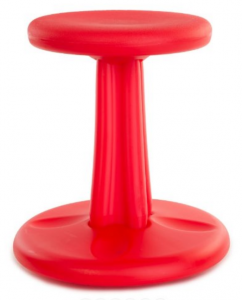Researchers have found evidence for the use of movement tools, but there are some children with whom these tools have the opposite effect.
Occupational therapists often advise parents and teachers to let children with ADHD use a variety of movement tools within the classroom. Some of my favorites include:
1. Wiggle Seat Cushions
13″ Stability Disc with Hand Pump $6.29 Add-On Amazon. These are a great deal, and not always available at this price. The usual price is closer to $14.00 each. These can be used on chairs or the floor.

2. Curved Bottom Stools
KORE on Amazon 10”, 12”, 14”, 16” Modles available. $69.99

IKEA NILSERIK Seat height: 20 1/8 ” to 28″ $49.99

3. Chair Kick Bands
 4. Standing Desk
4. Standing Desk
Houzz Moves in height from 30.5″ to 42.5″ $164.08

Flash Furniture on Amazon (Adjustable Range 29” – 40.75”) $94.42
 4. Movement Breaks
4. Movement Breaks
For children who have a high need to move, above and beyond regularly scheduled recess and physical education times, movement breaks can make a huge difference in their ability to attend, maintain focus, and have access to their working memory. Movement breaks are individually assigned by your child’s OT or Special Education teacher. I have created a resource that is designed teach children a variety of movement and breathing activities while collecting data to reveal which types of breaks are most effective for the individual child. Self-Regulation Skills Taught on TpT $19.99
Evidence for the effectiveness of the use of wiggle cushions, stools, standing desk, & movement breaks
It turns out that science continues to provide evidence for the positive use of movement within the classroom. Sarver, Dustin E., et al. in their study Hyperactivity in Attention-Deficit/Hyperactivity Disorder (ADHD): Impairing Deficit or Compensatory Behavior found that activity level had a significantly positive effect on working memory for children with ADHD.
A WORD of Caution:
While the majority of students with ADHD could do better on cognitive tasks when they were moving, the opposite was found to be true for typically developing boys. Teachers who practice principles of RTI might also consider promoting classroom cultures where every child gets what they need. If sitting on a wobble stool helps you to think and remember use it, but if it interferes don’t use it.

Researchers found that while movement options for kids with ADHD consistently helped working memory, it does not always help with task performance. While 50% of the ADHD children tested to do better with tasks, 17% performance deteriorated. What that means for us as therapists, parents, and teachers, is there is not one best method for every child. We must also look at what the task requirements are and how the individual child responds in order to make our best recommendations.
Reference: Sarver, Dustin E., et al. “Hyperactivity in attention-deficit/hyperactivity disorder (ADHD): Impairing deficit or compensatory behavior?.” Journal of abnormal child psychology 43.7 (2015): 1219-1232.
![]()

[inlinkz_linkup id=755510 mode=1]


Such a great post! My son is definitely a wiggler and a mover. Something I just put together last night: when eating meals, he will automatically stand up and pace near his chair when he’s talking about an idea that he’s excited about. I wonder if this points to a correlation between thinking and movement. The quintessential command to “sit still!” in order to focus is a guarantee he won’t be able to pay attention.
I have a specific question regarding classroom seating. My son, the wiggler, is HF autistic in a mainstream first grade classroom, supported by an aide, and needs repeated prompts to sit upright on the rug during “rug time”. He’s never been one to sit still, especially on the floor: he prefers to lay on his back while listening to what’s going on, or will sit up for a few minutes, roll onto his back (backwards, like a ball) and then sits up for another few moments. Plainly put, he’s always in constant motion, sometimes small movements, sometimes larger. He’s not conscious of it.
Have you ever had experience with a child who has trouble sitting upright during rug time, or otherwise sitting in an expected manner?
Hello Jessica, Yes I have worked with many children who struggle with sitting during ‘rug time’ similar to your son. The first item in this post, a wiggle seat cushion, can often help a great deal! I wonder if your son would also benefit from:
* A walking break before rug time
* Visual feedback like a picture of him sitting tall and attentive that is pulled out to remind him when he starts to lay down
* A thumbs up every minute or two that he is remaining sitting
* Or an option to stand behind the circle as long as he continued to participate
Best of luck! Thia
Great ideas, thanks. I haven’t tried some of these!
I have a bunch of those wiggle seat cushions (Thanks, DonorsChoose!). Thanks for more ideas on how to use them.
🙂
I had no idea that some of these stools aren’t good for growing boys. Thanks so much for sharing your wisdom in this matter.
Perhaps you could say these stools are not best to encourage learning and remembering for all children.
These are great tips! My kids love the wobbly stools & standing table. I also appreciate the word of caution 🙂
I have been thinking about adding more flexible seating options like these in my own room. I think it would provide more options for students who need it.